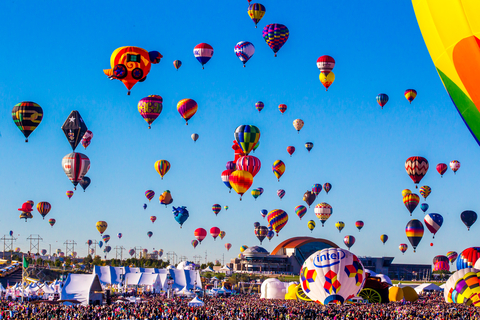Up and away: fabulous Balloon Festival ascends

Paul Smith dreamed about ballooning since childhood when he first read the Jules Verne classic, "Around the World in 80 Days." Adventures of the fastidious Phileas Fogg and his austere butler, Jean Passerpartout, planted a seed that went unwatered for nearly two decades.
As a young lawyer in the early 1980s, Smith traded some legal services for balloon flight lessons. The New Mexico resident earned his pilot's license and found himself enthralled by the simplicity of the sport.
"Mankind has always been intrigued by ballooning," Smith said. "The simplicity is definitely part of it. There are only two controls a burner that makes the balloon go up and a vent that makes it come down."
Eventually Smith put away his briefcase and donned a flight jacket. Today he runs the Albuquerque International Balloon Fiesta, the largest hot air balloon event in the world.
The Albuquerque fiesta includes more than 20 countries and 600 colorful balloons. Taking place in early fall, the event is one of many ballooning festivals occurring throughout the United States this summer.
Balloon festivals follow a patriotic lineage back to the Founding Fathers. American democracy soared high as the first balloons lifted skyward some 230 years ago.
"Ballooning gives everyone a sense of adventure and it hasn't changed much since the 18th century," said Kathy Leyendecker, publicist for the Albuquerque event. "You are at the mercy of wind and never really know where you are going to end up."
Leyendecker's enthusiasm for ballooning fills the air in her lungs and you can almost hear the sound of wind as she describes what it's like to watch a balloon or take a ride in one.
"You are being held by God at the end of a string," she said. "The landscape is moving below you. It's quiet because you are moving with the wind and the only sound is the burner which heats the envelope."
The envelope, that massive bulb-shaped bag, has always drawn stares. They are often colorful and provide a stark contrast against a flat sky. Synthetic fabrics such as nylon or polyester and impermeable sealers like silicone expanded the possibilities for ballooners.
A balloon rally may include shapes such as cartoon characters, vegetables and even the space shuttle. Envelope colors are nearly limitless.
Ever since it began ballooning has evoked a flair for the dramatic. The French brothers Joseph-Michel and Jacques-Etienne Montgolfier experimented with hot air balloons and materials at their southern France laboratory.
On Nov. 21, 1783, their experiments were unveiled on a clear cool day in Paris. It was the first demonstration of free manned flight.
From a nearby hotel room Benjamin Franklin watched as Frenchmen heralded manned aviation. He was 77 years old and one month earlier had signed the Treaty of Paris, which sealed independence for the United States of America.
Franklin helped free a nation from the tethers of tyranny and now witnessed the freeing of man from the constraints of gravity. The Montgolfier balloon floated over Paris and landed between windmills on the outskirts of town. Franklin predicted manned balloons would be used for military missions.
In January 1793, a French inventor named Jean-Pierre Blanchard visited Franklin's hometown of Philadelphia and conducted the first manned balloon flight in the New World. Franklin had died three years earlier but the festivities were witnessed by some other Revolutionary heavyweights.
George Washington, John Adams, Thomas Jefferson, James Madison and James Monroe watched as Blanchard lifted off and sailed to New Jersey. Two months later Washington was sworn in as the first American president and ballooning mania soared in the fledgling democracy.
"Ballooning gives everyone a sense of adventure and it hasn't changed much since the 18th century," said Leyendecker of the Albuquerque Balloon Fiesta.
Article by Jay Alling, editor of Sensible Driver. Write to jay@sensibledriver.com.